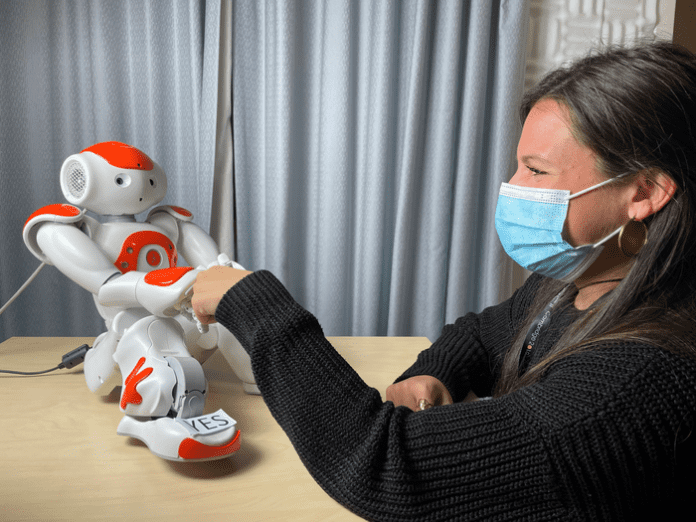
A new study suggests that robots could be more useful at assessing children’s mental well-being than parent-reported or self-reported testing.
A team of roboticists, computer scientists and psychiatrists from the University of Cambridge studied 28 children between eight and 13 and had a child-sized humanoid robot administer a series of standard psychological questionnaires to assess the children’s mental well-being.
“After I became a mother, I was much more interested in how children express themselves as they grow, and how that might overlap with my work in robotics,” said Professor Hatice Gunes, who leads the Affective Intelligence and Robotics Laboratory in Cambridge’s Department of Computer Science and Technology. “Children are quite tactile, and they’re drawn to technology. If they’re using a screen-based tool, they’re withdrawn from the physical world. But robots are perfect because they’re in the physical world – they’re more interactive, so the children are more engaged.”
Children confide successfully in the robot
The researchers found that the children were willing to confide in the robot, and some children shared information with the robot that they had not noted during online or in-person questionnaires.
The researchers outlined that the robots could be a useful addition to traditional methods of mental health assessment, although they are not intended to be a substitute for professional mental health support.
COVID-19 and the lack of schooling, socialising and isolation cause changes in children’s mental well-being and health. Before the pandemic, mental health conditions in children were increasing, and despite this, resources to address this rise were limited.
This led researchers to design an experiment to see if robots were useful for assessing children’s mental well-being.
“There are times when traditional methods aren’t able to catch mental wellbeing lapses in children, as sometimes the changes are incredibly subtle,” said Nida Itrat Abbasi, the study’s first author. “We wanted to see whether robots might be able to help with this process.”
Designing robots to assess children’s mental wellbeing
The participants took part in a one-to-one 45-minute session with a Nao robot – a humanoid robot about 60 cm tall. Before this meeting, the children and their parents or guardian completed a standard online questionnaire about the children’s mental well-being. Then, a parent or guardian and the researchers observed the children from another room whilst they spent time with the robot.
The children interacted with the robot throughout the sessions by speaking or touching sensors located on the robot’s hands and feet. Other sensors tracked participants’ heartbeat, head and eye movements.
During each session, the robot performed four different tasks:
- Asked open-ended questions about happy and sad memories over the last week;
- Administered the Short Mood and Feelings Questionnaire (SMFQ);
- Administered a picture task inspired by the Children’s Apperception Test (CAT), where the children answered questions related to the imagery;
- Administered the Revised Children’s Anxiety and Depression Scale (RCADS) for generalised anxiety, panic disorder and low mood.
The children were divided into three groups following the SMFQ, depending on how likely they were to be struggling with their mental well-being. The children all reported their enjoyment of spending time with the robot.
The researchers’ findings illuminated that the children with differing levels of well-being concerns interacted inversely with the robots. The children not experiencing any well-being issues interacted with the robot more positively; however, the children facing mental well-being struggles interacted with the robot more negatively, expressing their true feelings and experiences.
“Since the robot we use is child-sized and completely non-threatening, children might see the robot as a confidante – they feel like they won’t get into trouble if they share secrets with it,” said Abbasi. “Other researchers have found that children are more likely to divulge private information – like that they’re being bullied, for example – to a robot than they would be to an adult.”
The researchers noted that while their results show that robots could be a useful tool for the psychological assessment of children, it is not a substitute for human interaction.
“We don’t have any intention of replacing psychologists or other mental health professionals with robots, since their expertise far surpasses anything a robot can do,” said co-author Dr Micol Spitale. “However, our work suggests that robots could be a useful tool in helping children to open up and share things they might not be comfortable sharing at first.”
The researchers hope to expand their children’s mental well-being survey in the future by including more participants and following them over a longer period. They are also exploring if video chatting with the robot could be a useful tool.









